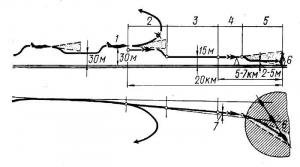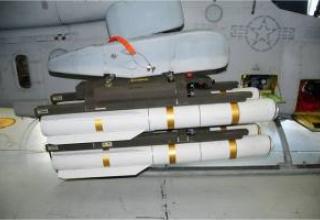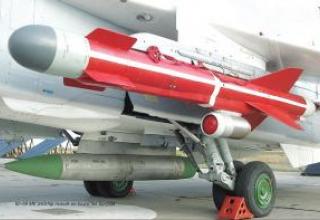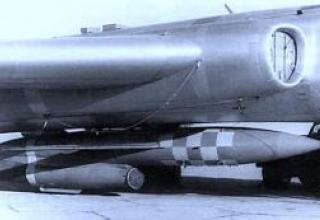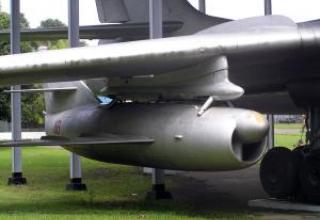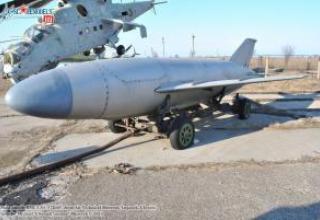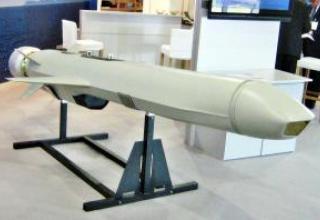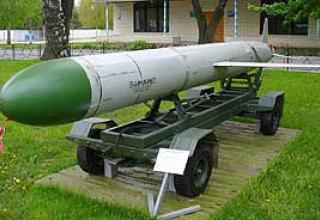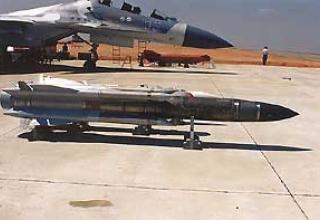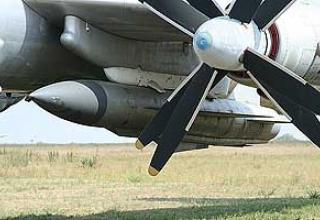The anti-ship missile "Kormoran" was adopted by the German Navy in 1976.
In 1987 a new modification of the missile - "Kormoran Mk.2" with an improved guidance system came into service. The Kormoran missiles were initially armed with Starfighter R-104 fighter-bombers and later Tornado fighter-bombers.
Composition:
The rocket has a normal aerodynamic pattern with a cross-shaped wing and steering wheels. The hull is made up of three compartments. The first of them is an active radar homing head (SAR), the second - the combat unit and the fuse with a safety executive mechanism, a vertical correction gyroscope, two-gyroscope inertial platform with a calculator, time relay. The third compartment accommodates a marching motor, processing and guidance units, a radio altimeter with antennas, steering servo motors, a power supply and starting accelerators built into the housing.
The blast time BC is designed to engage targets like a squadron destroyer. The CNS can operate in passive mode.
Kormoran missiles can be fired in two ways.
For the first of them, the coordinates of the detected target are manually entered into the missile's computing inertial navigation system in advance. On a course of convergence of the aircraft radar is not included, guidance is carried out by the calculator. The attacking aircraft is flying at an altitude of about 30 m. For preliminary clarification of the coordinates of the target it performs a short-term maneuver with a set altitude and simultaneous inclusion of the radar. Clarified target movement parameters are automatically entered into the inertial system calculator. After entering the combat course, the pilot regains altitude and activates the radar again to finalize the target coordinates. The missile can be launched either before entering the ship's air defense zone (usually at a range of 20 km and from an altitude of 30 m) or after leaving it. In the latter case, the carrier instantly performs an anti-missile manoeuvre and exits the enemy's firing range. After launch, the missile is accelerated by the launch accelerators to supersonic speed (the acceleration time of the accelerators is less than 1 s), which soon decreases. The flight at an altitude of about 15 m is controlled by a radio altimeter. In the marching section of the trajectory, the missile is pre-manoeuvred by an inertial system with a deviation within the accumulated error. A few kilometres from the target, the active homing head is activated and the radar search area begins. The homing head can detect a surface target when the sea waves up to six points and provide guidance when performing evasive manoeuvres under electronic warfare conditions.
The second method provides less visibility of the aircraft, because the missile is launched using an optical sight. After visual detection of a target, its motion parameters are entered into the onboard control system. After capturing the target by the equipment of the homing head is carried out missile launch, and the aircraft carrier performs anti-aircraft maneuver and leaves the zone of air defense of the attacked ship. The missile is immediately reduced to a height of 2-3 m, the inertial system works only at the command of the homing head.
During flight tests, the Kormoran missiles hit targets at wave heights above 3.5 m. In the homing area, the flight altitude is reduced to 2-3 m, which provides a direct hit of the missile aboard the ship.
The relatively short range of the Kormoran rocket is explained by the fact that it is designed for use in limited areas of the Baltic and North Seas, in particular, in the pre-beast and strait areas.
Characteristics:
| Range of fire, km | 30 |
| Minimum launch height, m | 50 |
| Maximum missile flight speed | 0.9М |
| The length of the rocket, mm | 4400 |
| The diameter of the rocket body, mm | 340 |
| Wingspan, mm | 1000 |
| Start weight , kg | 660 |
| Fighting unit | |
| Type | blast |
| Weight,kg | 160 |
Testing:
One of the first carriers of the complex is a multipurpose nuclear submarine of the project 885 "Ash", which belongs to the fourth generation of submarines. The keelmark in the series, called "Severodvinsk", took place on December 21, 1993. The boat carries 24 missiles in inclined launch shafts. The natural model of the new anti-ship missile in an export version (a variant for underwater, surface and shore-based), was first publicly demonstrated at the exhibition MAKS-97. It was also exhibited at MAKS-99.
The advertising passport for the small rocket ship of project 21632 "Tornado" (approved on 26.04.2008) indicates the possibility of placing the Yakhont complex as one of the weapon variants.
According to military analysts' forecasts, the Yakhont complex will have no analogues in the world for another 10 years. This can be proved by the interest expressed by foreign buyers. A number of countries of the Asia-Pacific region, the Middle East, which in the past bought Russian ships and boats with cruise missiles, have already become interested in the novelty of the domestic military industrial complex. PCR Yakhont also has good prospects in terms of upgrading foreign-built ships, where it can replace the Harpoon, Exocet, and Otomat anti-ship complexes.
Sources:
- Б.И.Родионов, Н.Н.Новичков "Крылатые ракеты в морском бою", -М.: Военное издательство, 1987.-214с.
- Широкорад А.Б. "История авиационного вооружения", -Мн.: Харвест, 1999.-560с.


